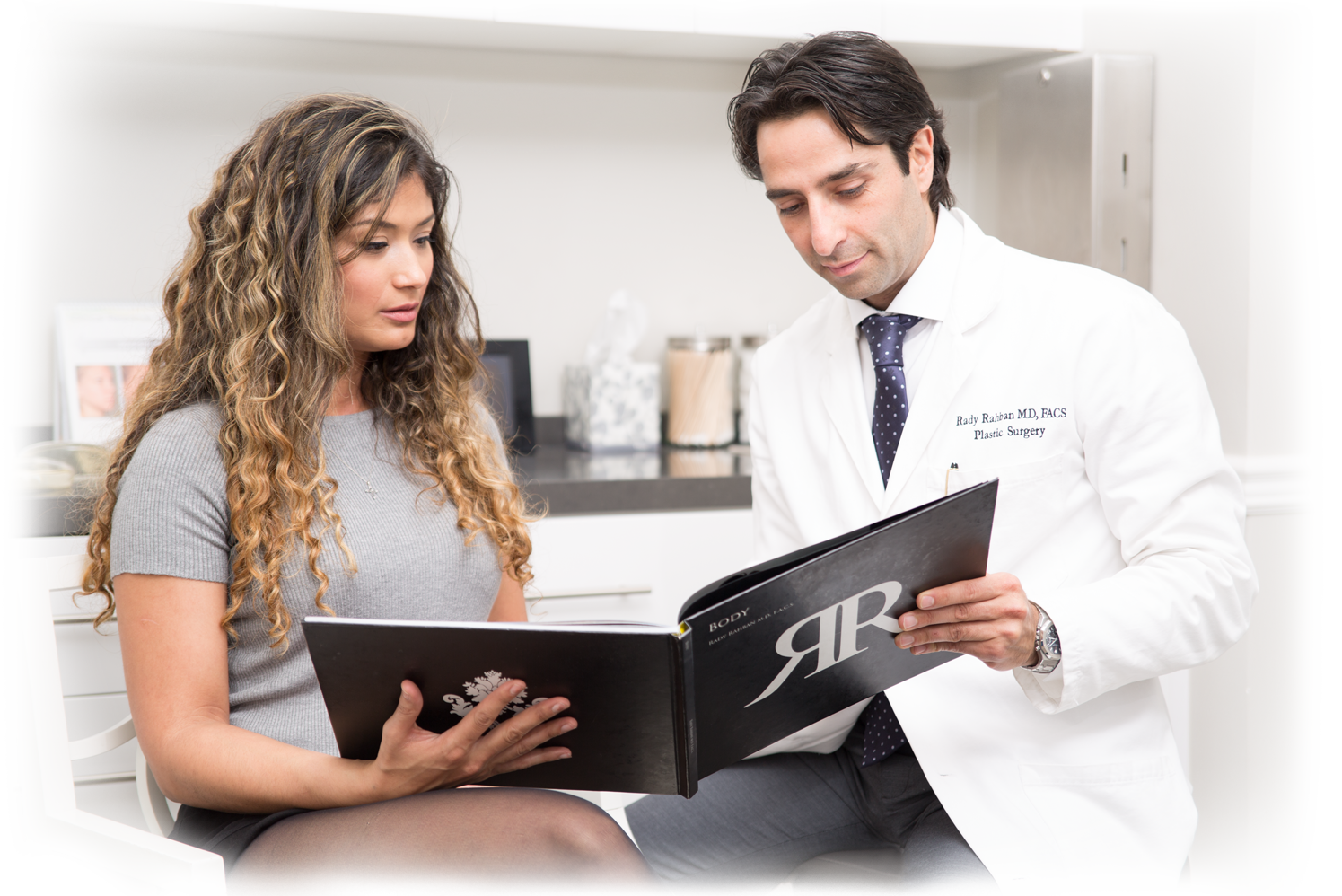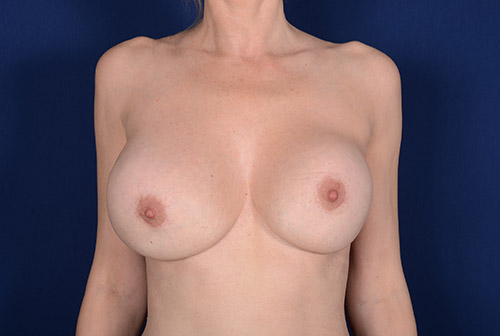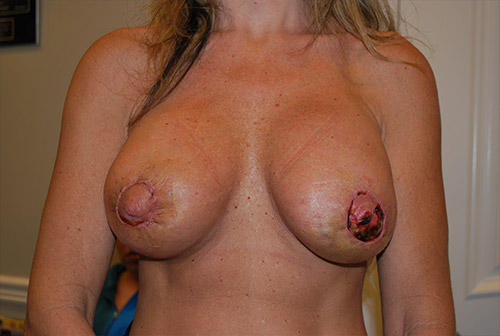Asymmetry
Although we strive for symmetrical correction, sometimes one nipple corrects better than the other, thereby leaving some degree of asymmetry.
Inverted nipples affect approximately 2% of women. While inverted nipples certainly present a cosmetic issue, they may also cause an inability to breast-feed. In some cases, inverted nipples are present since birth. In others, they develop as the result of milk ducts and other tissue in the breasts shortening over time.
Inverted nipple correction is a brief surgical procedure done to reverse inverted nipples, restoring them to more projected position. Inverted nipple correction is a very minor surgery and is usually done under local anesthesia. It may easily be done in conjunction with other Los Angeles Mommy Makeover procedures, such as a breast reduction, breast lift or breast augmentation.
Any woman who has some degree of inverted nipples is a candidate for this procedure. Thoroughly discussing your aesthetic goals for nipple inversion correction surgery with Dr. Rahban will only help ensure that you get one of the best Mommy Makeovers Los Angeles can lay claim to. Note there are two types of inverted nipples:
For individuals with dynamic inverted nipples after pregnancy, it is a matter of weighing whether this procedure is worth it. When an inverted nipple can dynamically become erect, the sensation of the nipple can be critical with regard to intimacy. Additionally, dynamic inverted nipples may be able to breastfeed at times. Inverted nipple correction carries the risk of loss of sensation and ability to breastfeed. Therefore these two sides must be weighed before deciding to undergo the procedure.
If your nipples are always inverted, you most likely don’t care about sensation and were never able to breastfeed. Therefore, there is generally less consideration for women with statically inverted nipples.
Candidates for inverted nipple correction are ideally done breastfeeding and childbearing.
Note: while each surgeon approaches the consultation process differently, Dr. Rahban, who is a Mommy Makeover specialist, feels they should all have the same basic elements, ensuring patients leave very well informed regarding surgery. Below is how Dr. Rahban conducts a consultation.

Your consultation should be done by your plastic surgeon and not by his staff, such as his coordinator. In many cases, patients are offered free consultations, but you must understand that often means you’ll get a hurried consult. As a point of reference, Dr. Rahban on average spends up to an hour with each patient, reviewing not only what the patient came in for, but also explaining all the nuances such as the risks and alternatives to what that patient has requested.
There is no way to accelerate the dissemination of knowledge when it is so complicated and crucial.
Second, after an examination, Dr. Rahban defines the exact problem, allowing you to better understand what your body has been through. Next, he lays out your options, including the degree of correction that you can anticipate and other factors. Finally, he will discuss what you can expect from your post partum inverted nipple correction, both in terms of the cosmetic result, as well as the physical and mental aspects.
As an extension of this, Dr. Rahban also reviews what patients should not expect from surgery. He is well known for telling his patients the truth and establishing a healthy level of expectation. Most patient dissatisfaction is related to inaccurate understanding and expectation of their surgery. Dr. Rahban deals in full disclosure to prevent this from occurring.
In the interest of helping his patients fully understand the procedure, Dr. Rahban will take this opportunity to review all potential risks. While some risks are quite unlikely, he still wants his patients to be aware of the potential downsides of surgery. All surgeries come with risks. Therefore, he believes the only time to engage in surgery is if the benefits far outweigh the risks. If you will only have a mild improvement, Dr. Rahban will most definitely recommend you do not undergo the procedure.
During a consultation, Dr. Rahban has one primary purpose—total patient education. He wants each patient to fully understand the nuances of inverted nipple correction, as well as every risk and exactly how the procedure applies to them, allowing them to make the best decision for themselves. With his honest, candid approach, Dr. Rahban brings a new level of care to ensuring his patients know exactly how inverted nipple correction works.
Note: while no two surgeons perform this procedure identically, most techniques have a similar series of steps. Below is a brief overview of Dr. Rahban’s technique, allowing you to gain a more detailed understanding regarding how your surgery will be performed. The more you know, the more control you have.
Because inverted nipples after breastfeeding are usually caused by some kind of tethering, the corrective surgery usually involves releasing the fibers that keep the nipples inverted. This begins with an incision at the base of the nipple to access the ducts or fibrous tissue that is holding the nipple down. From there, tissue is rearranged in order to allow for improved nipple projection. Finally, the incision is closed with precise sutures that create minimal scarring.
Special care is then taken to maintain the nipple in the erect position during the healing process. Dr. Rahban uses a special technique to keep them projected. This is crucial, as the nipple has a tendency to retract during the early healing phase.
Because inverted nipple correction is a relatively minor procedure, there is minimal preparation necessary. All in all, there are two primary factors that should be present to undergo inverted nipple correction:
Your surgeon’s office will help you with any pre-operative guidelines you are fully prepared for the procedure. In this way, the entire experience can be smooth and comfortable.
Inverted nipple correction after childbirth requires very little downtime once the procedure is over. In general, patients can return to their normal routine the very next day. We ask that patients refrain from vigorous exercise for some time after surgery and avoid any compression-type bras such as a sports bra for approximately 6 weeks. Full recovery is expected after two weeks.
Inverted nipple correction risks include but are not limited to:
Although we strive for symmetrical correction, sometimes one nipple corrects better than the other, thereby leaving some degree of asymmetry.

While very rare, partial or complete necrosis of the nipple can occur during the release of the fibrous connections. This is due to poor blood supply to the nipple following the procedure.

In the process of releasing the tethering material, most nipples become partially asensate. For most, this is not an issue, as they have not been able to feel their nipple due to its retraction. Again, this becomes an issue if at times your nipples do come out. This may be a reason not to undergo surgery.
During the procedure, some of the ducts will be transected during the release of the tethering material, making patients unable to breastfeed. This is not an issue if your nipples have been fixed. However, if you were able to breastfeed partially and are having more children, this will be something to consider.
Despite releasing the tethering fibrous tissues, in the healing process new scar bands can form, pulling the nipple back inwards and undoing the correction.
There is no standard cost for inverted nipple correction as there are many unique variables. Below is a list of the elements that will determine the cost of your procedure so you understand what exactly you are paying for.

Below are specific questions to ask your surgeon during your consultation. Each of these will allow you to understand his or her approach and thus make an informed decision. To print these questions so you can ask your surgeon, see link below to download a copy take with you to your consultation. Contact us today for arguably the best mommy makeover Beverly Hills has to offer.
Because inverted nipples are usually caused by some kind of tethering, the corrective surgery usually involves releasing the fibers that keep the nipples inverted. This begins with an incision at the base of the nipple to access the ducts or fibrous tissue that is holding the nipple down. From there, tissue is rearranged in order to allow for improved nipple projection. Finally, the incision is closed with precise sutures that create minimal scarring.
Special care is then taken to maintain the nipple in the erect position during the healing process. Dr. Rahban uses a special technique to keep them projected. This is crucial, as the nipple has a tendency to retract during the early healing phase.